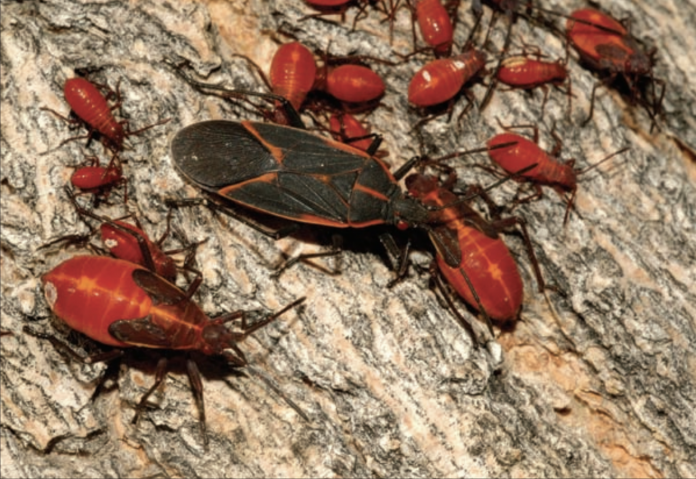
Boxelder bugs can be found throughout the eastern United States, wherever the boxelder maple grows. As temperatures dip in the fall, boxelder bugs will search for a safe place to overwinter. Generally, they will congregate in homes and buildings near female boxelders and other host plants.
Like stinkbugs and Asian lady beetles, boxelder bugs gather in large numbers, creating a nuisance for anyone whose home gets invaded. Besides appearing in mass, they can stain curtains, other fabrics and walls with their feces once they’re inside your home. They’ve also been known to emit an unpleasant odor. They’re basically the equivalent of the native North American stinkbug.
Keeping boxelder bugs out
In the fall, adult boxelder bugs search for cracks and crevices in walls to secure a protected, overwintering site. This is how many of them wind up finding their way into the living areas of homes.
Mechanical exclusion prevents adult boxelders from exerting your home to overwinter. If you’ve noticed them inside, check the exterior of your home for entry points, including cracks around:
- windows
- doors
- siding
- utility pipes
- behind chimneys
- underneath wood fascia
- crawl space openings and basement windows
- vents
- light fixtures
- air conditioners
Seal any crevices you discover with silicone or silicone-latex caulk. Damaged screens on doors and windows should also be repaired or replaced.
If completely sealing the exterior of your home or building is difficult or impossible, exterior applications of insecticides may help prevent infestations. The chosen insecticide should consist of a synthetic pyrethroid — deltamethrin, cyfluthrin, lambda-cyhalothrin, cypermethrin, sumithrin or tralomethrin — and should be applied by a licensed professional in the fall before boxelder bugs have begun entering your home. The application will be effective for about a week after it’s applied.
You may also try a laundry detergent-water mixture, recommended by the United States Department of Agriculture.
Instructions: Dissolve 1/2 cup of laundry detergent in a gallon of hot water. Put mixture into a spray bottle. Spray directly on boxelder bugs.
Getting rid of boxelder bugs indoors
Although they will kill boxelder bugs, pesticides are not recommended indoors. One reason is that any dead bodies left behind from an insecticidal dust treatment or fogger will attract other bugs to feed on it. Another reason is that these products have a limited effect over time. While they will kill any pests initially exposed, ones who weren’t exposed will survive and emerge later. Lastly, using pesticides indoors isn’t safe for pets and children who could come into contact with any surface the poison touched. Even if you clean every surface of your home, following a pesticide application, there’s always a chance of exposure. Not to mention you’d have to completely clean your entire house after each treatment to ensure safety. Although they work, they’re not a long-term solution to manage boxelder bugs indoors.
The recommended management techniques to get rid of boxelder bugs indoors are removing them using your vacuum cleaner and sealing off cracks. Common openings where boxelder bugs gain access to living areas are cracks under or behind baseboards, around window and door trim, and around exhaust fans or lights in ceilings. By ensuring these entry points are sealed, you can prevent the insects from crawling out of wall voids and attic space. Then when they exit your home in the spring, you can seal their entrances on the outside of your home to prevent them from reentering next fall.
Related Content
- Simplest way to eliminate stink bugs indoors
- How to seal Asian lady beetles, stink bugs out of your house
- How to keep Asian lady beetles out of your house










I want to get rid of these hideous little bugs outside. I have tried spraying with bug sprays but nothing seems to put a dent in their number. What do you suggest I do?